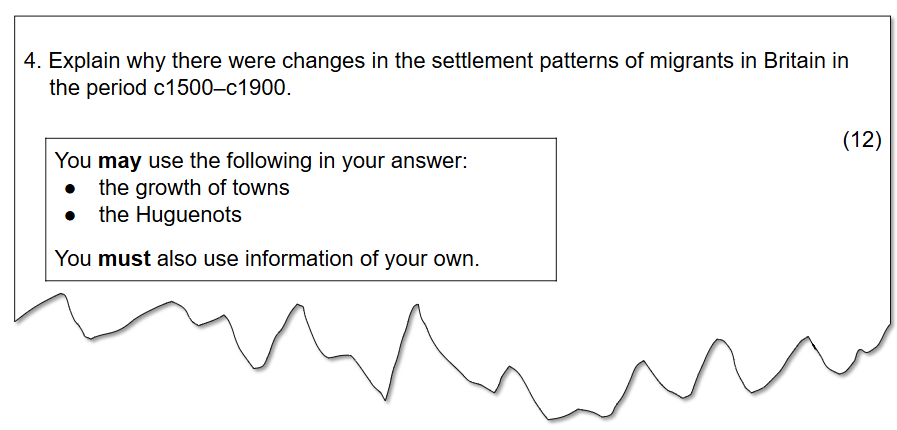The 12 Mark "Explain Why" Question (Edexcel GCSE History): Revision Note
Exam code: 1HI0
Summary of Question 4
Question 4 requires you to provide an analytical explanation of the event, development, theme or factor outlined in the question
This question will require you to use second-order concepts in your answer
Amount of marks | 12 |
|---|---|
The time that you should spend on the question | No more than 20 minutes 5 minutes of planning 10–15 minutes of writing |
An example of the type of question you may encounter can be seen below:

In previous years, this question has focused on the following topics in Migrants in Britain:
Year of exam | Question topic |
|---|---|
2022 | Viking migration brought change to England (opens in a new tab) |
2023 | Changes in the legal status of migrants (opens in a new tab) |
2024 | Changes in attitudes about migration to Britain |
What are second-order concepts?
Second-order concepts are thinking tools historians use to explain the past
The second-order concepts are:
Cause and consequence
Change and continuity
Similarities and differences
Historical significance
In the example question, the second-order concept is change and continuity
The example question asks you to explain why patterns of settlement changed in the time period c1500–c1900
You can show change and continuity by considering:
The speed of change in patterns of settlement, migrant experiences and impacts
What caused change or continuity in the experiences or impacts of migrants in Britain
What caused improvements in the treatment of migrants
How to answer an "explain why" question
You are asked to explain a change, continuity or consequence in migration
You will receive two stimulus points
These are areas of knowledge to discuss in your question
If you only discuss these two stimulus points, you cannot access Level 4 (9–12 marks)
You must discuss three areas of knowledge in your answer to access Level 4
You should always plan your answers before writing them. You should consider:
What three areas of knowledge you are going to use
For the example question, you could include changes in civil liberties, attitudes towards immigrants and the empire
How they demonstrate change, continuity or consequence across the time period outlined in the question
"Explain why" question structure
Your answer should include:
Specific and relevant own knowledge
The second-order concept in the question
A sustained explanation
A logical structure
Your answers could be written in PEEL paragraphs:
P — Make a point about the question
E — Use evidence that supports the point that you have made (K)
Use multiple pieces of evidence from the time period in the question
E — Explain the question (SOC)
Explain how the evidence caused a change, continuity or consequence in the development outlined in the question
L — Link your explanation to how significant this factor is for the change, continuity or consequence (SOC)
To achieve full marks, you need to repeat this structure three times
The question is out of 12 marks:
6 marks for demonstrating a wide range of specific knowledge of the period and the topic (K)
6 marks for the analysis of the key second-order concepts (SOC)
Worked example of an "Explain why" question
Worked Example
Explain why there were changes in the settlement patterns of migrants in Britain in the period c1500–c1900.
(12)
You may use the following in your answer:
You must also use information of your own. |
Answer:
One reason why migrant settlement changed between c1500 and c1900 was the growth of towns. Over this time, towns and cities got much bigger, especially during the Industrial Revolution. Migrants moved to towns because there were more jobs in factories, docks and markets (K). In the earlier part of this period, migrants like the Flemish weavers lived in small towns, such as Sandwich and Canterbury. However, by the 1800s, migrants were more likely to live in large cities such as Manchester, Liverpool and London (SOC). Therefore, settlement became more focused in large industrial cities due to factors such as work and housing (SOC).
Another reason was religious persecution in other countries. For example, in the 1600s, the Huguenots came from France to escape being attacked for their religion. They often settled in London, where they could form communities and practise their religion more freely (K). In the 1800s, Jewish people similarly settled in London due to pogroms in Eastern Europe. These patterns show that migrants often settled near others with shared beliefs or backgrounds (SOC). Therefore, religion affected where migrants chose to live.
A final reason was Britain’s growing trade and empire. During this time, Britain took control of more places around the world, including India, parts of Africa and the Caribbean (K). This meant there were more connections between Britain and its colonies. People from these parts of the empire often came to Britain on trade ships or to find work. Many settled in port cities such as London, Cardiff and Liverpool, where ships arrived and jobs were available (SOC). These changes helped new migrant communities grow in port cities where they had work and support.

Unlock more, it's free!
Did this page help you?